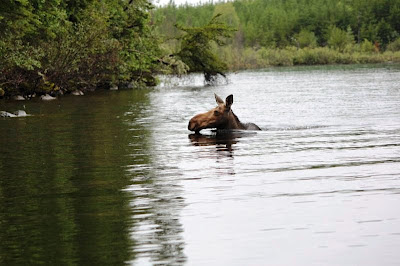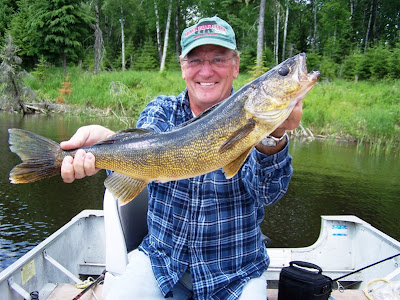
It won't be too long and the scene above will be a reality again on Red Lake.
Just like the rest of North America,
Northwestern Ontario has experienced one of the warmest winters in history. I would say our winter has been more like what central Wisconsin usually gets.
As a result,
ice thickness on the lakes, including Red Lake, is far less than normal, probably less than two feet compared to the usual three feet.
The ice itself is a beautiful blue colour, the best kind to support weight and also the best kind to melt. Its dark hue readily absorbs the sun's rays. The worst for melting is slushy white ice. Although this ice isn't very strong as far as weight bearing goes, it is the hardest to melt since it reflects light.
There was very little snow until just recently. Most areas have received 1-2 feet of snow in the last couple of weeks. That snowfall would normally delay
ice-out were it not for the temperatures we're getting. It is supposed to be 8-12 C every day for the next week. If these warm temperatures are accompanied by wind, which is likely, the snow is going to be history.
The record ice-out on Red Lake is April 20, tied in 2010. The historical average is May 8.
Climate change has meant we can throw historical data out the window. It is possible this year that we could beat the record by weeks.
If that does indeed happen, how will it affect fishing?
Most species of fish and wildlife use a combination of factors in their behaviour mechanisms. For spring spawners such as northern pike and walleye, both the photoperiod (the length of daylight) plus the water temperature comes into play in deciding when to spawn.
We have seen early spawns right after early breakups in the past but would this happen if ice-out is a month earlier than normal? I don't know. The eggs in the fish may not be developed enough for spawning to take place that soon and the photo period is also not right.
My guess is that spawning time can vary by a couple of weeks but not a month.
The other critical factor is the weather after spawning takes place. It seems the best scenario is for a fairly rapid water warming such as happens in early, warm springs. We're seeing the benefits of such seasons right now with the explosion of walleye on Red Lake that started from great spawns years ago.
Walleye fishing this year stands to be spectacular. We will be reaping the harvest of those previous early-season great spawns which this year will mean tons of fish in the best-eating 16-18 inch lengths as well as lots in the mid-20s. Early season walleye fishing at the west end of Red Lake is also the best when the water warms which should be the case in 2012.
I know our early-season pike fishermen would rather have a late ice-out. They like to have the pike still gathered around their spawning sites and entice them with dead bait. If we have an extra-early ice-out this year our first couple of weeks of fishing may more resemble early June fishing which, by the way, is also excellent for pike. However, fishermen mostly use artificials rather than bait at that time. It's just going to take a change in techniques this year.
For the most part an early ice-out is good news for fish. It can give them more time for growing, gives the young a headstart on preparing for the next winter and lets the water weeds grow better and longer. Basically everything is more productive.
It would also be a godsend for Brenda and me and our staff. We always have a ton of work to accomplish before we open for the season.
Click to go back to our
websiteClick to see the latest on the
blog


















